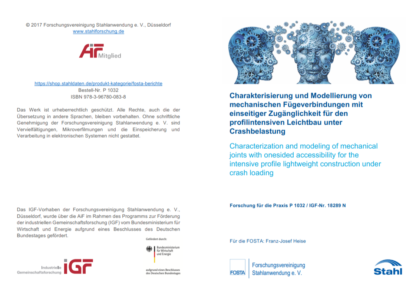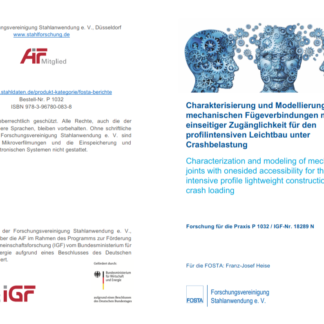Description
P 1032 – Characterization and modeling of mechanical joints with onesided accessibility for the intensive profile lightweight construction under crash loading
The automobile industry focuses on light weight constructions because of the legal requirements to reduce the production of carbon dioxide. The decrease of carbon dioxide production to average 95g CO2/km in the passenger car market is determined until 2020. Because of its 30% fraction of the gross vehicle weight the body in white has the biggest potential for light weight constructions using high strength steel in thin sheet thicknesses and lightweight materials like aluminum and fiber reinforced plastics. The demand of both-sided accessibility is not possible to realize in all cases because of the profile intensive material mix. The joining technology gets more and more tasks for one-sided joining accessibility, which are solved by using joining techniques like flow drill screwing and tac-setting.
The aim of this research project is the experimental investigation and numerical modeling of the joint strength, the load bearing capacity and the deformation and fracture behavior of mechanical joining techniques for one-sided accessibility under crash loading. For the flow drill screwing and tac-setting the properties should be determined using the LWF-KS-2- test setup. The test results are used for the development and the calibration of a finite element model for these joints in crash simulation. The model will be validated by simulation of the performed component test.)
The chosen materials were characterized by tension tests in two strain rates, one quasi-static and one dynamic rate. The results are the basis for subsequent simulations. After the sampling of the investigated joints of the project, the joint properties for the FDS and tacjoints the properties were determined exemplary. To understand the influence of the position of the joint in component, the peeling and shear tests were performed with varied specimen geometry.
The development of a modelling and characterization method for joints for profile intensive lightweight construction like flow drilling screws and tacs will make it possible for steel users in construction and simulation to make reliable statements about the load bearing capacity of connected steel structures under crash loading. This allows the efficient and economic development of components made from highstrength steels and thereby contributes to the qualification of these steels against other lightweight materials.
Published in:
2017
Authors:
Dr.-Ing. S. Sommer, Prof. Dr.-Ing. G. Meschut




